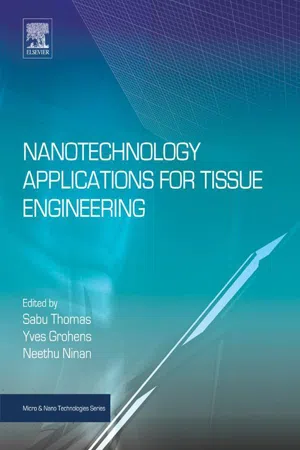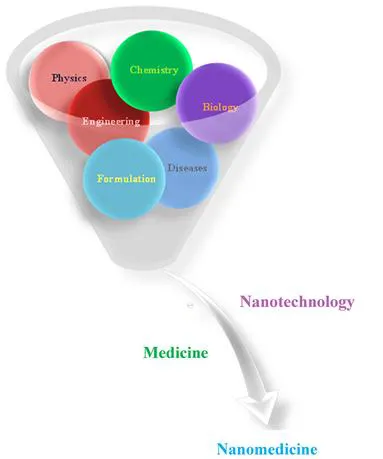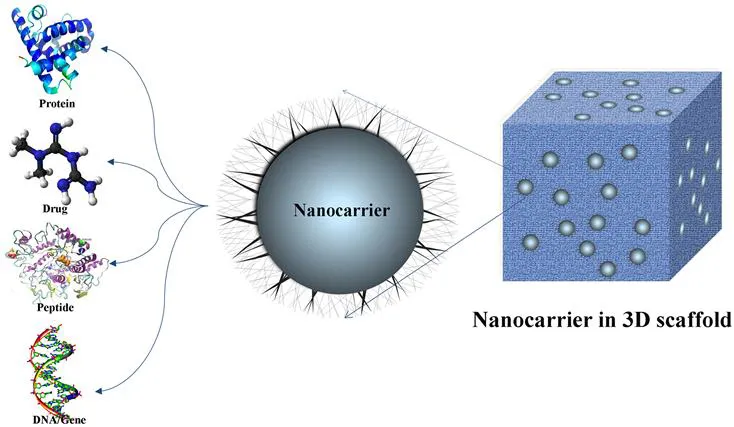
Nanotechnology Applications for Tissue Engineering
- 336 pages
- English
- ePUB (mobile friendly)
- Available on iOS & Android
Nanotechnology Applications for Tissue Engineering
About This Book
Tissue engineering involves seeding of cells on bio-mimicked scaffolds providing adhesive surfaces. Researchers though face a range of problems in generating tissue which can be circumvented by employing nanotechnology. It provides substrates for cell adhesion and proliferation and agents for cell growth and can be used to create nanostructures and nanoparticles to aid the engineering of different types of tissue. Written by renowned scientists from academia and industry, this book covers the recent developments, trends and innovations in the application of nanotechnologies in tissue engineering and regenerative medicine. It provides information on methodologies for designing and using biomaterials to regenerate tissue, on novel nano-textured surface features of materials (nano-structured polymers and metals e.g.) as well as on theranostics, immunology and nano-toxicology aspects. In the book also explained are fabrication techniques for production of scaffolds to a series of tissue-specific applications of scaffolds in tissue engineering for specific biomaterials and several types of tissue (such as skin bone, cartilage, vascular, cardiac, bladder and brain tissue). Furthermore, developments in nano drug delivery, gene therapy and cancer nanotechonology are described. The book helps readers to gain a working knowledge about the nanotechnology aspects of tissue engineering and will be of great use to those involved in building specific tissue substitutes in reaching their objective in a more efficient way. It is aimed for R&D and academic scientists, lab engineers, lecturers and PhD students engaged in the fields of tissue engineering or more generally regenerative medicine, nanomedicine, medical devices, nanofabrication, biofabrication, nano- and biomaterials and biomedical engineering.
- Provides state-of-the-art knowledge on how nanotechnology can help tackling known problems in tissue engineering
- Covers materials design, fabrication techniques for tissue-specific applications as well as immunology and toxicology aspects
- Helps scientists and lab engineers building tissue substitutes in a more efficient way
Frequently asked questions
Information
Nanomedicine and Tissue Engineering
Keywords
1.1 Introduction
1.1.1 Nanomedicine

1.1.2 Tissue Engineering
1.2 Relationship of Nanomedicine and Tissue Engineering


1.2.1 Nanomedicine Approaches in Bone Tissue Engineering
Table of contents
- Cover image
- Title page
- Table of Contents
- Copyright
- List of Contributors
- About the Editors
- Preface
- Chapter 1. Nanomedicine and Tissue Engineering
- Chapter 2. Biomaterials: Design, Development and Biomedical Applications
- Chapter 3. Electrospinning of Polymers for Tissue Engineering
- Chapter 4. Biomimetic Nanofibers for Musculoskeletal Tissue Engineering
- Chapter 5. Hydrogels—Promising Candidates for Tissue Engineering
- Chapter 6. 3D Scaffolding for Pancreatic Islet Replacement
- Chapter 7. Scaffolds with Antibacterial Properties
- Chapter 8. Dermal Tissue Engineering: Current Trends
- Chapter 9. Chitosan and Its Application as Tissue Engineering Scaffolds
- Chapter 10. Cell Encapsulation in Polymeric Self-Assembled Hydrogels
- Chapter 11. Nanotechnology-Enabled Drug Delivery for Cancer Therapy
- Chapter 12. Nanomedicine in Theranostics
- Chapter 13. Upconversion Nanoparticles
- Chapter 14. Gold Nanoparticles in Cancer Drug Delivery
- Chapter 15. Toxicology Considerations in Nanomedicine
- Chapter 16. Role of Nanogenotoxicology Studies in Safety Evaluation of Nanomaterials
- Chapter 17. Future of Nanotechnology in Tissue Engineering
- Index